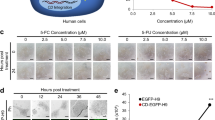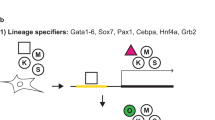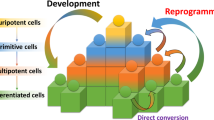Abstract
Reprogramming of somatic cells is a valuable tool to understand the mechanisms of regaining pluripotency and further opens up the possibility of generating patient-specific pluripotent stem cells. Reprogramming of mouse and human somatic cells into pluripotent stem cells, designated as induced pluripotent stem (iPS) cells, has been possible with the expression of the transcription factor quartet Oct4 (also known as Pou5f1), Sox2, c-Myc and Klf4 (refs 1–11). Considering that ectopic expression of c-Myc causes tumorigenicity in offspring2 and that retroviruses themselves can cause insertional mutagenesis, the generation of iPS cells with a minimal number of factors may hasten the clinical application of this approach. Here we show that adult mouse neural stem cells express higher endogenous levels of Sox2 and c-Myc than embryonic stem cells, and that exogenous Oct4 together with either Klf4 or c-Myc is sufficient to generate iPS cells from neural stem cells. These two-factor iPS cells are similar to embryonic stem cells at the molecular level, contribute to development of the germ line, and form chimaeras. We propose that, in inducing pluripotency, the number of reprogramming factors can be reduced when using somatic cells that endogenously express appropriate levels of complementing factors.
This is a preview of subscription content, access via your institution
Access options
Subscribe to this journal
Receive 51 print issues and online access
$199.00 per year
only $3.90 per issue
Buy this article
- Purchase on Springer Link
- Instant access to full article PDF
Prices may be subject to local taxes which are calculated during checkout




Similar content being viewed by others
References
Takahashi, K. & Yamanaka, S. Induction of pluripotent stem cells from mouse embryonic and adult fibroblast cultures by defined factors. Cell 126, 663–676 (2006)
Okita, K., Ichisaka, T. & Yamanaka, S. Generation of germline-competent induced pluripotent stem cells. Nature 448, 313–317 (2007)
Wernig, M. et al. In vitro reprogramming of fibroblasts into a pluripotent ES-cell-like state. Nature 448, 318–324 (2007)
Maherali, N. et al. Directly reprogrammed fibroblasts show global epigenetic remodeling and widespread tissue contribution. Cell Stem Cell 1, 55–70 (2007)
Meissner, A., Wernig, M. & Jaenisch, R. Direct reprogramming of genetically unmodified fibroblasts into pluripotent stem cells. Nature Biotechnol. 25, 1177–1181 (2007)
Nakagawa, M. et al. Generation of induced pluripotent stem cells without Myc from mouse and human fibroblasts. Nature Biotechnol. 26, 101–106 (2008)
Wernig, M., Meissner, A., Cassady, J. P. & Jaenisch, R. c-Myc is dispensable for direct reprogramming of mouse fibroblasts. Cell Stem Cells 2, 11–12 (2008)
Aoi, T. et al. Generation of pluripotent stem cells from adult mouse liver and stomach cells. Science doi: 10.1126/science.1154884; published online 14 February 2008.
Takahashi, K. et al. Induction of pluripotent stem cells from adult human fibroblasts by defined factors. Cell 131, 861–872 (2007)
Yu, J. et al. Induced pluripotent stem cell lines derived from human somatic cells. Science 318, 1917–1920 (2007)
Park, I. H. et al. Reprogramming of human somatic cells to pluripotency with defined factors. Nature 451, 141–146 (2008)
Episkopou, V. SOX2 functions in adult neural stem cells. Trends Neurosci. 28, 219–221 (2005)
Miyagi, S. et al. The Sox-2 regulatory regions display their activities in two distinct types of multipotent stem cells. Mol. Cell. Biol. 24, 4207–4220 (2004)
Masui, S. et al. Pluripotency governed by Sox2 via regulation of Oct3/4 expression in mouse embryonic stem cells. Nature Cell Biol. 9, 625–635 (2007)
Ryan, A. K. & Rosenfeld, M. G. POU domain family values: flexibility, partnerships, and developmental codes. Genes Dev. 11, 1207–1225 (1997)
Do, J. T. & Scholer, H. R. Nuclei of embryonic stem cells reprogram somatic cells. Stem Cells 22, 941–949 (2004)
Pollard, S. M., Conti, L., Sun, Y., Goffredo, D. & Smith, A. Adherent neural stem (NS) cells from fetal and adult forebrain. Cereb. Cortex 16 (Suppl 1). i112–i120 (2006)
Sherr, C. J. & McCormick, F. The RB and p53 pathways in cancer. Cancer Cell 2, 103–112 (2002)
Rowland, B. D., Bernards, R. & Peeper, D. S. The KLF4 tumour suppressor is a transcriptional repressor of p53 that acts as a context-dependent oncogene. Nature Cell Biol. 7, 1074–1082 (2005)
Peeper, D. S. et al. A functional screen identifies hDRIL1 as an oncogene that rescues RAS-induced senescence. Nature Cell Biol. 4, 148–153 (2002)
Miura, T. et al. Neural stem cells lose telomerase activity upon differentiating into astrocytes. Cytotechnology 36, 137–144 (2001)
Nunes, M. C. et al. Identification and isolation of multipotential neural progenitor cells from the subcortical white matter of the adult human brain. Nature Med. 9, 439–447 (2003)
Ruau, D. et al. Pluripotency associated genes are reactivated by chromatin modifying agents in neurophere cells. Stem Cells 26, 920–926 (2008)
Zaehres, H. & Daley, G. Q. Transgene expression and RNA interference in embryonic stem cells. Methods Enzymol. 420, 49–64 (2006)
Szabo, P. E., Hubner, K., Scholer, H. & Mann, J. R. Allele-specific expression of imprinted genes in mouse migratory primordial germ cells. Mech. Dev. 115, 157–160 (2002)
Irizarry, R. A. et al. Summaries of Affymetrix GeneChip probe level data. Nucleic Acids Res. 31, e15 (2003)
Acknowledgements
We thank J. Müller-Keuker for critically reviewing the manuscript, M. Stehling for fluorescence-activated cell sorting analysis, C. Ortmeier for real-time PCR analysis, B. Schäfer for histology, C. Becker, B. Kratz and B. Denicke for probe processing and array hybridization, and T. Kitamura for the pMX retroviral vector. J.B.K. was supported by the Interdepartmental Graduate-Programme for Experimental Life Sciences (iGEL) at the University of Münster. The microarray analyses were funded in part by a grant from the Deutsche Forschungsgemeinschaft DFG SPP1109.
Author Contributions J.B.K. (project design, generation and characterization of iPS cells and NSCs, and preparation of manuscript), H.Z. (project design, generation of iPS cells, and preparation of manuscript), G.W., L.G., V.S., K.K. and D.W.H. (characterization of iPS cells), M.J.A.-B., D.R., M.Z. (microarray and bioinformatics) and H.R.S. (project design, and preparation of manuscript).
Author information
Authors and Affiliations
Corresponding author
Supplementary information
Supplementary Information
The file contains Supplementary Methods, Supplementary Tables 1-2 and Supplementary Figures 1-8 with Legends. (PDF 1180 kb)
Supplementary Movie
The file contains Supplementary Movie 1. (MOV 5218 kb)
Rights and permissions
About this article
Cite this article
Kim, J., Zaehres, H., Wu, G. et al. Pluripotent stem cells induced from adult neural stem cells by reprogramming with two factors. Nature 454, 646–650 (2008). https://doi.org/10.1038/nature07061
Received:
Accepted:
Published:
Issue Date:
DOI: https://doi.org/10.1038/nature07061
This article is cited by
-
Toll-like receptors 2 and 4 differentially regulate the self-renewal and differentiation of spinal cord neural precursor cells
Stem Cell Research & Therapy (2022)
-
Current status and future prospects of patient-derived induced pluripotent stem cells
Human Cell (2021)
-
Double sperm cloning (DSC) is a promising strategy in mammalian genetic engineering and stem cell research
Stem Cell Research & Therapy (2020)
-
Functions of p53 in pluripotent stem cells
Protein & Cell (2020)
-
Advances in Pluripotent Stem Cells: History, Mechanisms, Technologies, and Applications
Stem Cell Reviews and Reports (2020)
Comments
By submitting a comment you agree to abide by our Terms and Community Guidelines. If you find something abusive or that does not comply with our terms or guidelines please flag it as inappropriate.



